Lavas and Other Volcanic Deposits
Lavas of different types produce different landforms. The differences depend on the chemical composition, gas content, and temperature of the lavas. The higher the silica content and the lower the temperature, for example, the more viscous the lava is, and the more slowly it moves. The more gas a lava contains, the more violent its eruption is likely to be.
Types of Lava
Erupted lavas, the end products of volcanic geosystems, usually solidify into one of three major types of igneous rock (see Chapter 4): basalt, andesite, or rhyolite.
Basaltic Lavas
Basalt is an extrusive igneous rock of mafic composition (high in magnesium, iron, and calcium) and has the lowest silica content of the three igneous rock types; its intrusive equivalent is gabbro. Basaltic magma, the product of mantle melting, is the most common magma type. It is produced along mid-ocean ridges and at hot spots within plates, as well as in continental rift valleys and other zones of extension. The volcanic island of Hawaii, which is made up primarily of basaltic lava, lies above a hot spot.
Basaltic lavas erupt when hot, fluid magmas fill up a volcano’s plumbing system and overflow (Figure 12.2). Basaltic eruptions are rarely explosive. On land, a basaltic eruption sends lava down the flanks of the volcano in great streams that can engulf everything in their path (Figure 12.3). When cool, these lavas are black or dark gray, but at their high eruption temperatures (1000°C to 1200°C), they glow in reds and yellows. Because their temperatures are high and their silica content low, they are extremely fluid and can flow downhill fast and far. Lava streams flowing as fast as 100 km/hour have been observed, although velocities of a few kilometers per hour are more common. In 1938, two daring Russian volcanologists measured temperatures and collected gas samples while floating down a river of molten basalt on a raft of colder solidified lava. The surface temperature of the raft was 300°C, and the river temperature was 870°C. Lava streams have been observed to travel more than 50 km from their sources.


316
Basaltic lava flows take on different forms depending on how they cool. On land, they solidify as pahoehoe (pronounced pa-hoh-ee-hoh-ee) or aa (ah-ah) (Figure 12.4).
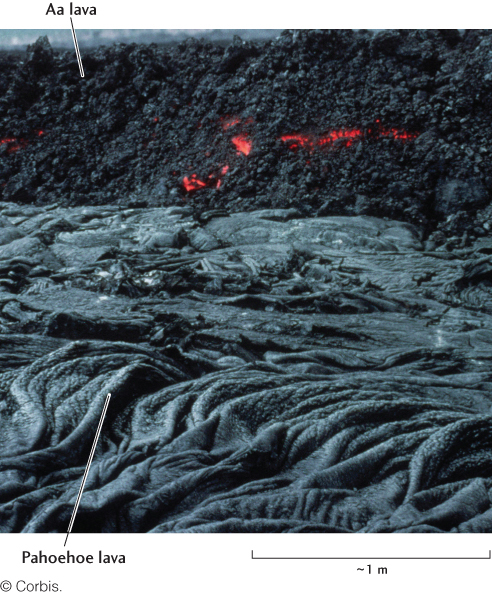
Pahoehoe (the word is Hawaiian for “ropy”) forms when a highly fluid lava spreads in sheets and a thin, glassy, elastic skin congeals on its surface as it cools. As the molten liquid continues to flow below the surface, the skin is dragged and twisted into coiled folds that resemble rope.
“Aa” is what the unwary exclaim after venturing barefoot onto lava that looks like clumps of moist, freshly plowed earth. Aa forms when lava loses its gases and consequently flows more slowly than pahoehoe, allowing a thick skin to form. As the flow continues to move, the thick skin breaks into rough, jagged blocks. The blocks pile up in a steep front of angular boulders that advances like a tractor tread. Aa is truly treacherous to cross. A good pair of boots may last about a week on it, and the traveler can count on cut knees and elbows.
A single downhill basaltic flow commonly has the features of pahoehoe near its source, where the lava is still fluid and hot, and of aa farther downstream, where the flow’s surface—having been exposed to cool air longer—has developed a thicker outer skin.
317
Basaltic lava that cools under water forms pillow lavas: piles of ellipsoidal, pillowlike blocks of basalt about a meter wide (Figure 12.5). Pillow lavas are an important indicator that a region on dry land was once under water. Scuba-diving geologists have actually observed pillow lavas forming on the ocean floor off Hawaii. Tongues of molten basaltic lava develop a tough, plastic skin on contact with the cold ocean water. Because the lava inside the skin cools more slowly, the pillow’s interior develops a crystalline texture, whereas the quickly chilled skin solidifies to a crystal-less glass.
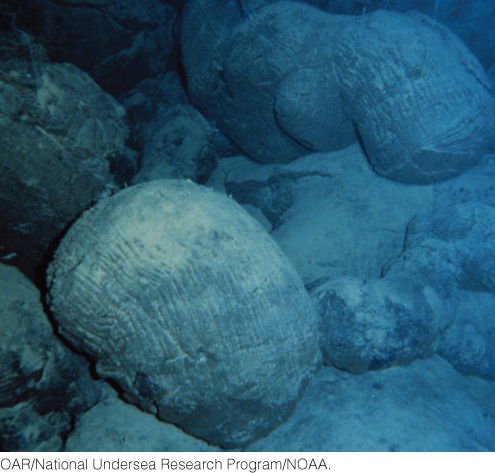
Andesitic Lavas
Andesite is an extrusive igneous rock with an intermediate silica content; its intrusive equivalent is diorite. Andesitic magmas are produced mainly in the volcanic mountain belts above subduction zones. The name comes from a prime example: the Andes of South America.
The temperatures of andesitic lavas are lower than those of basalts, and because their silica content is higher, they flow more slowly and lump up in sticky masses. If one of these sticky masses plugs the central vent of a volcano, gases can build up beneath the plug and eventually blow off the top of the volcano. The explosive eruption of Mount St. Helens in 1980 (Figure 12.6) is a famous example.
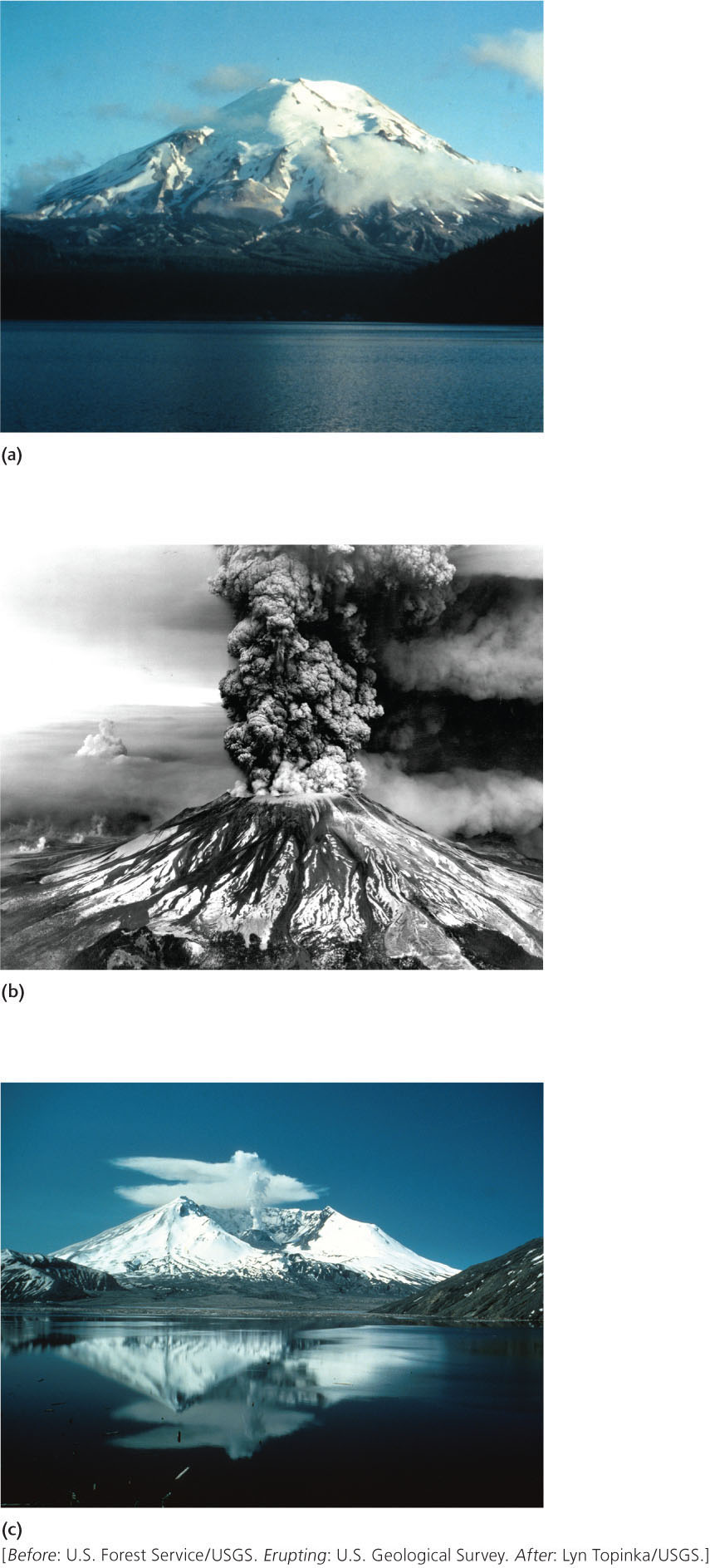
318
Some of the most destructive volcanic eruptions in history have been phreatic, or steam, explosions, which occur when hot, gas-charged magma encounters groundwater or sea-water, generating vast quantities of superheated steam (Figure 12.7). The island of Krakatau, an andesitic volcano in Indonesia, was destroyed by a phreatic explosion in 1883. This legendary eruption was heard thousands of kilometers away, and it generated a tsunami that killed more than 40,000 people.
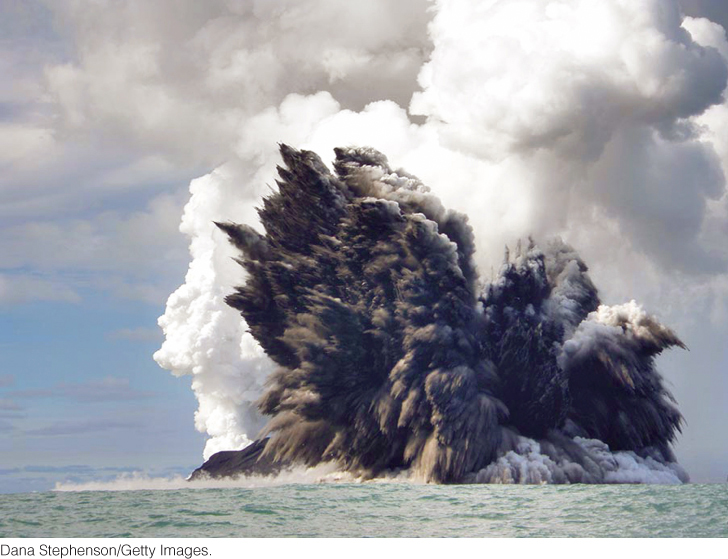
Rhyolitic Lavas
Rhyolite is an extrusive igneous rock of felsic composition (high in sodium and potassium) with a silica content greater than 68 percent; its intrusive equivalent is granite. It is light in color, often a pretty pink. Rhyolitic magmas are produced in zones where heat from the mantle has melted large volumes of continental crust. Today, the Yellowstone volcano is producing huge amounts of rhyolitic magma that are building up in shallow chambers.
Rhyolite has a lower melting point than andesite, becoming liquid at temperatures of only 600°C to 800°C. Because rhyolitic lavas are richer in silica than any other lava type, they are the most viscous. A rhyolitic flow typically moves more than 10 times more slowly than a basaltic flow, and it tends to pile up in thick, bulbous deposits (Figure 12.8). Gases are easily trapped beneath rhyolitic lavas, and large rhyolitic volcanoes such as Yellowstone produce the most explosive of all volcanic eruptions.
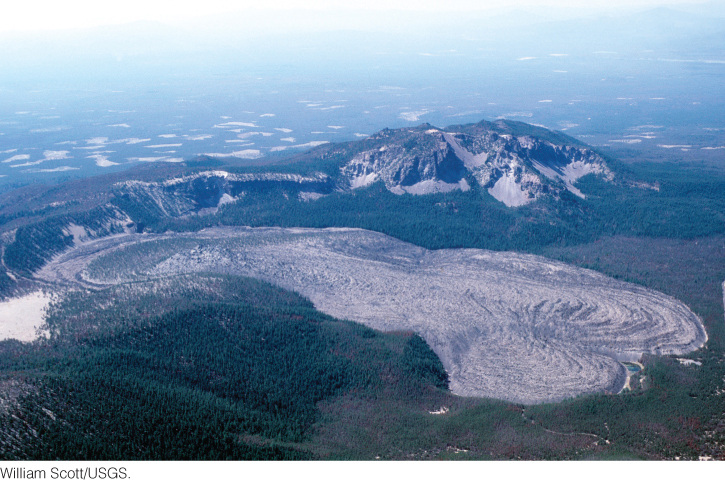
319
Textures of Volcanic Rocks
The textures of volcanic rocks, like the surfaces of solidified lava flows, reflect the conditions under which they solidified. Coarse-grained textures with visible crystals can result if lavas cool slowly. Lavas that cool quickly tend to have fine-grained textures. If they are silica-rich, rapidly cooled lavas can form obsidian, a volcanic glass.
Volcanic rock often contains little bubbles, created as gases are released during an eruption. As we have seen, magma is typically charged with gas, like soda in an unopened bottle. When magma rises toward Earth’s surface, the pressure on it decreases, just as the pressure on the soda drops when the bottle cap is removed. And just as the carbon dioxide in the soda forms bubbles when the pressure is released, the water vapor and other dissolved gases escaping from lava as it erupts create gas cavities, or vesicles (Figure 12.9). Pumice is an extremely vesicular volcanic rock, usually rhyolitic in composition. Some pumice has so many vesicles that it is light enough to float on water.

Pyroclastic Deposits
Water and gases in magma can have even more dramatic effects than bubble formation. Before magma erupts, the confining pressure of the overlying rock keeps these volatiles from escaping. When the magma rises close to the surface and the pressure drops, the volatiles may be released with explosive force, shattering the lava and any overlying solidified rock and sending fragments of various sizes, shapes, and textures into the air (Figure 12.10). These fragments, known as pyroclasts, are classified according to their size.
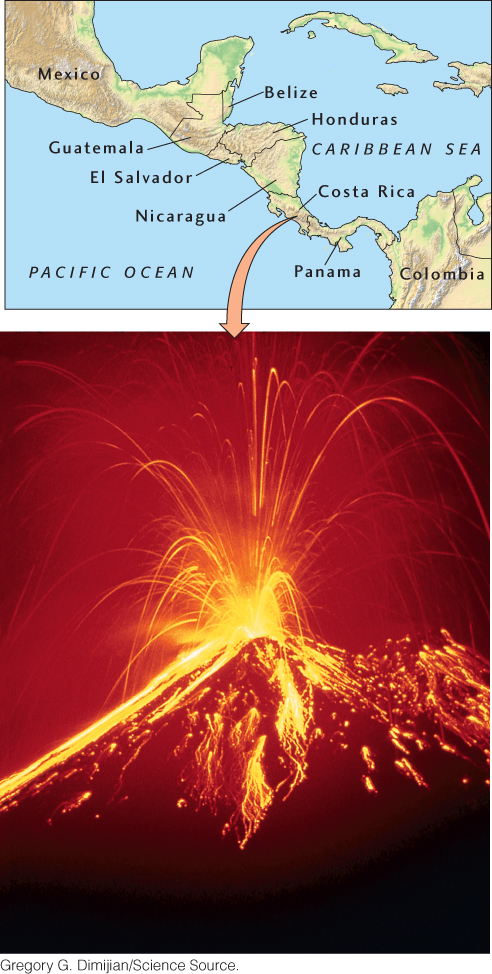
Volcanic Ejecta
The finest pyroclasts are fragments less than 2 mm in diameter, which are classified as volcanic ash. Volcanic eruptions can spray ash high into the atmosphere, where ash that is fine enough to stay aloft can be carried great distances. Within 2 weeks of the 1991 eruption of Mount Pinatubo in the Philippines, for example, its ash was traced all the way around the world by Earth-orbiting satellites.
Fragments ejected as blobs of lava that cool in flight and become rounded, or as chunks torn loose from previously solidified volcanic rock, can be much larger. These fragments are called volcanic bombs (Figure 12.11). Volcanic bombs as large as houses have been thrown more than 10 km by explosive eruptions.

320
Sooner or later, these pyroclasts fall to Earth, building the largest deposits near their source. As they cool, the hot, sticky fragments become welded together (lithified). Rocks created from smaller fragments are called tuffs; those formed from larger fragments are called breccias (Figure 12.12).
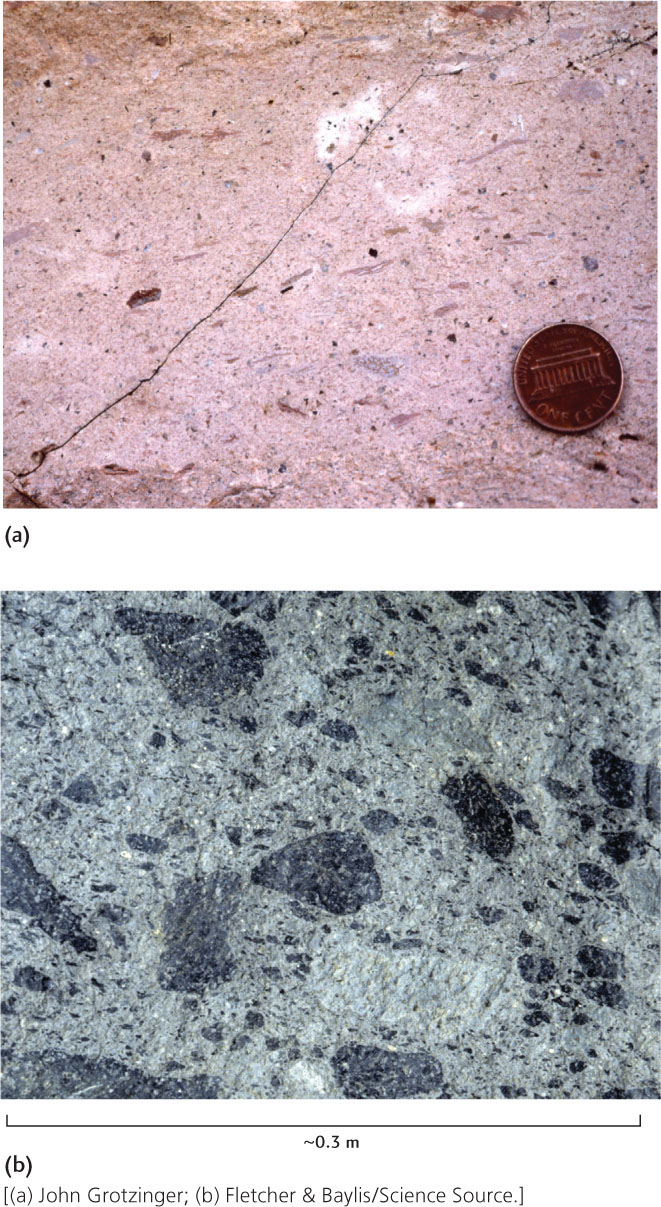
Pyroclastic Flows
Pyroclastic flows, which are particularly spectacular and often deadly, occur when a volcano ejects hot ash and gases in a glowing cloud that rolls downhill at high speeds. The solid particles are buoyed up by the hot gases, so there is little frictional resistance to their movement.
In 1902, with very little warning, a pyroclastic flow with an internal temperature of 800°C exploded from the side of Mont Pelée, on the Caribbean island of Martinique. The avalanche of choking hot gas and glowing volcanic ash plunged down the slopes at a hurricane speed of 160 km/hour. In 1 minute and with hardly a sound, the searing emulsion of gas and ash enveloped the town of St. Pierre and killed 29,000 people. It is sobering to recall the statement of one Professor Landes, issued the day before the cataclysm: “The Montagne Pelée presents no more danger to the inhabitants of St. Pierre than does Vesuvius to those of Naples.” Professor Landes perished with the others. In 1991, French volcanologists Maurice and Katia Krafft were killed by a pyroclastic flow on Mount Unzen, Japan (Figure 12.13).
